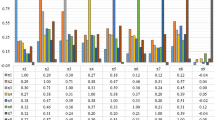Abstract
This study aimed to investigate the accuracy and feasibility of support vector machine (SVM) modeling in predicting non-sentinel lymph node (NSLN) status in patients with SLN-positive breast cancer. Clinicopathological data were collected from 201 cases with sentinel lymph node biopsy breast cancer and included patient age, tumor size, histological type and grade, vascular invasion, estrogen receptor status, progesterone receptor status, CerbB2 status, size and number of positive SLNs, number of negative SLNs, and positive SLN membrane invasion. Feature vector selection was based on a combination of statistical filtration and model-dependent screening. The arbitrary combination with the smallest p value for SVM input was selected, the predicative results of the model were evaluated by a 10-fold cross validation, and a training model was established. Using SLN-positive patients as a double-blind test set, 85 patients were input into the model to analyze its sensitivity and specificity. The combination with the highest cross-validation accuracy was selected for the SVM model and consisted of the following: the number and size of positive SLNs, the number of negative SLNs, and the membrane invasion of positive SLNs. The training accuracy of the model established with the four variables was 92 %, and its cross-validation veracity was 87.6 %. The accuracy of an 85-patient double-blind test of the SVM model was 91.8 %. In conclusion, this SVM model is an accurate and feasible method for the prediction of NSLN status in SLN-positive breast cancer and is conducive to guide clinical treatment.




Similar content being viewed by others
References
Nakhlis F, Golshan M. Bevacizumab: where do we go from here in breast cancer? Transl Cancer Res. 2012;1(1):55–6.
Chen W, Zheng R, Zhang S, Zhao P, Li G, Wu L, et al. Report of incidence and mortality in China cancer registries, 2009. Chin J Cancer Res. 2013;25(1):10–21.
Zhang BN, Cao XC, Chen JY, Chen J, Fu L, Hu XC, et al. Guidelines on the diagnosis and treatment of breast cancer (2011 edition). Gland Surg. 2012;1(1):39–61.
Rashid OM, Takabe K. The evolution of the role of surgery in the management of breast cancer lung metastasis. J Thorac Dis. 2012;4(4):420–4.
Veronesi U, Paganelli G, Viale G, Luini A, Zurrida S, Galimberti V, et al. A randomized comparison of sentinel-node biopsy with routine axillary dissection in breast cancer. N Engl J Med. 2003;349(6):546–53.
Mansel RE, Fallowfield L, Kissin M, Goyal A, Newcombe RG, Dixon JM, et al. Randomized multicenter trial of sentinel node biopsy versus standard axillary treatment in operable breast cancer: the ALMANAC Trial. J Natl Cancer Inst. 2006;98(9):599–609.
Fan F. Sentinel lymph node micrometastases and isolated tumor cells in breast cancer: an evolving field. Gland Surg. 2012;1(1):5–6.
Purushotham AD, Upponi S, Klevesath MB, Bobrow L, Millar K, Myles JP, et al. Morbidity after sentinel lymph node biopsy in primary breast cancer: results from a randomized controlled trial. J Clin Oncol. 2005;23(19):4312–21.
Bernet L, Cano R. Metastatic sentinel node and axillary lymphadenectomy revisited. Gland Surg. 2012;1(1):7–8.
McLaughlin SA, Wright MJ, Morris KT, Giron GL, Sampson MR, Brockway JP, et al. Prevalence of lymphedema in women with breast cancer 5 years after sentinel lymph node biopsy or axillary dissection: objective measurements. J Clin Oncol. 2008;26(32):5213–9.
Nelson V, Rademaker A, Kaklamani V. Paradigm of polyendocrine therapy in endocrine responsive breast cancer: the role of fulvestrant. Chin Clin Oncol. 2013;2(1):10.
Ashikaga T, Krag DN, Land SR, Julian TB, Anderson SJ, Brown AM, et al. Morbidity results from the NSABP B-32 trial comparing sentinel lymph node dissection versus axillary dissection. J Surg Oncol. 2010;102(2):111–8.
Shah-Khan M, Boughey JC. Evolution of axillary nodal staging in breast cancer: clinical implications of the ACOSOG Z0011 Trial. Cancer Control. 2012;19(4):267–76.
Giuliano AE, Haigh PI, Brennan MB, Hansen NM, Kelley MC, Ye W, et al. Prospective observational study of sentinel lymphadenectomy without further axillary dissection in patients with sentinel node-negative breast cancer. J Clin Oncol. 2000;18(13):2553–9.
Turner RR, Ollila DW, Krasne DL, Giuliano AE. Histopathologic validation of the sentinel lymph node hypothesis for breast carcinoma. Ann Surg. 1997;226(3):271–6.
Kamath VJ, Giuliano R, Dauway EL, Cantor A, Berman C, Ku NN, et al. Characteristics of the sentinel lymph node in breast cancer predict further involvement of higher-echelon nodes in the axilla: a study to evaluate the need for complete axillary lymph node dissection. Arch Surg. 2001;136(6):688–92.
Van Zee KJ, Manasseh DM, Bevilacqua JL, Boolbol SK, Fey JV, Tan LK, et al. A nomogram for predicting the likelihood of additional nodal metastases in breast cancer patients with a positive sentinel node biopsy. Ann Surg Oncol. 2003;10(10):1140–51.
Barranger E, Coutant C, Flahault A, Delpech Y, Darai E, Uzan S. An axilla scoring system to predict non-sentinel lymph node status in breast cancer patients with sentinel lymph node involvement. Breast Cancer Res Treat. 2005;91(2):113–9.
Pal A, Provenzano E, Duffy SW, Pinder SE, Purushotham AD. A model for predicting non-sentinel lymph node metastatic disease when the sentinel lymph node is positive. Br J Surg. 2008;95(3):302–9.
Kohrt HE, Olshen RA, Bermas HR, Goodson WH, Wood DJ, Henry S, et al. Bay Area SLN Study. New models and online calculator for predicting non-sentinel lymph node status in sentinel lymph node positive breast cancer patients. BMC Cancer. 2008;8:66.
Sattlecker M, Bessant C, Smith J, Stone N. Investigation of support vector machines and Raman spectroscopy for lymph node diagnostics. Analyst. 2010;135(5):895–901.
Conflicts of interest
None
Author information
Authors and Affiliations
Corresponding author
Rights and permissions
About this article
Cite this article
Ding, X., Xie, S., Chen, J. et al. A support vector machine model for predicting non-sentinel lymph node status in patients with sentinel lymph node positive breast cancer. Tumor Biol. 34, 1547–1552 (2013). https://doi.org/10.1007/s13277-013-0683-5
Received:
Accepted:
Published:
Issue Date:
DOI: https://doi.org/10.1007/s13277-013-0683-5




